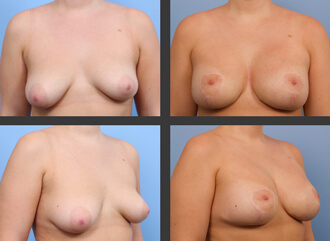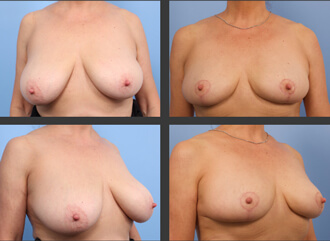Breast asymmetry correction involves surgical procedures to balance the size, shape, or position of asymmetrical breasts. It can be performed through various methods, such as breast augmentation, reduction, or lift, tailored to the patient’s specific needs. The surgeon may use implants, fat grafting, or tissue reshaping techniques.
Reasons for Breast Asymmetry Correction
Breast asymmetry is a common issue for women that can appear during or after puberty. If you have breasts that look different from one another, this is not usually a sign of a severe issue. Causes can range widely from person to person. For example, conditions such as breast hypoplasia, Poland syndrome, or juvenile hypertrophy can make the breasts look asymmetrical. Other causes can include:
- Significant weight gain or loss
- Hereditary
- Pregnancy or breastfeeding
- Trauma or injury to the breasts
- Development issues during puberty
- Breast cancer treatment or mastectomy (surgical removal of one or both breasts)
- Changes in hormones
Breast asymmetry can manifest in various ways, including differences in size or lift. Nipples may also differ in size, shape, or position on the breasts. The severity of the issue is subjective, and the decision to undergo surgery depends on the patient’s level of discomfort or dissatisfaction with their breasts.
Breast Asymmetry with Dr Broadhurst
“I pride myself on the individual care and support I provide each of my patients. From your first consultation, I will work one-on-one with you to tailor a treatment plan to suit your body.”

Consultation
Your Initial Consultation
Before surgery, you will need to have a meeting with us to assess various important factors. Dr Broadhurst will ask you questions about your medical history, any prior surgeries, and any current medications. During this time, you can express your concerns about your breasts and what you hope to achieve with breast asymmetry correction.
Dr Broadhurst will assess your breast condition. He will then be able to outline a treatment plan that suits your specific needs. After this meeting, you should have a clear idea of what the surgery entails.
Your Second Consultation
Your second meeting with us will take place at one of our Brisbane, Sunshine Coast, Hervey Bay, or Bundaberg locations.
In this meeting, we will discuss the surgery in detail, address any final questions you may have, and provide information on what to expect before, during, and after the procedure. We will discuss preparation for the surgery, the surgical process, and post-operative care, including instructions on how to ensure proper healing of your breasts. Dr Broadhurst encourages you to ask any questions you may have about the procedure.
Procedure
What to expect during your procedure?
Breast asymmetry correction is performed in a hospital under general anaesthesia. Each procedure is tailored to the patient, depending on their needs and level of asymmetry. Some patients may need more than one type of surgery. The length of the surgery will depend on which method the surgeon uses, as discussed in your consultation.
Depending on the breast shape and size, you may need surgery on one or both of your breasts. The different options include:
Breast Augmentation

Breast augmentation makes the breast or breasts larger with implants. Inserting implants into one or both of your breasts can help increase volume. Implants can be round or teardrop, smooth or textured. You can discuss these options with the surgeon prior to surgery. Different implants of different sizes can be inserted into each breast to achieve symmetry.
Breast Reduction

Breast reduction is suitable for patients who are concerned about one or both breasts being too large. This surgical procedure involves removing excess skin and fat to make the breasts smaller and symmetrical. This surgery can also help alleviate shoulder and back pain caused by excessive breast size and weight.
Breast Lift

A breast lift changes the position of the breast on the chest. The surgeon can perform a breast lift alone or with augmentation or reduction. This breast asymmetry correction method is also used for raising nipples that are low or facing downwards.
Fat Transfer

During a fat transfer, the surgeon takes fat grafts from other areas of the body and transfers them to the breast to add volume. This process increases the size of the breasts with fat from your own body.
Nipple Repositioning

Also called nipple reshaping, this involves surgically correcting nipple issues caused by stretched skin. It can address size and asymmetry, as well as nipples that are inverted or protruding.


